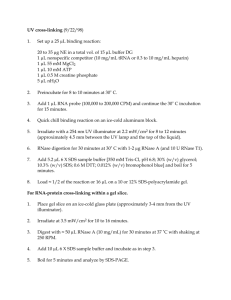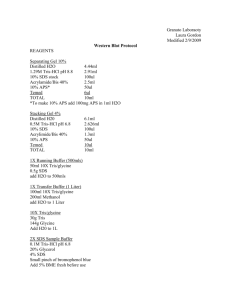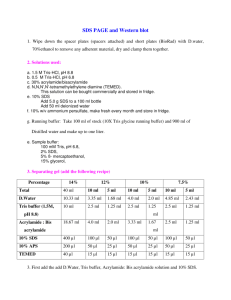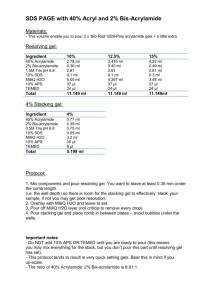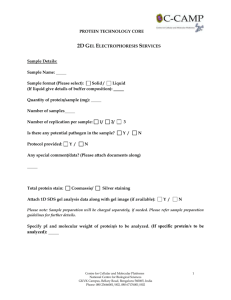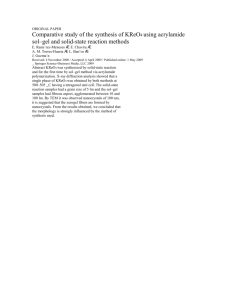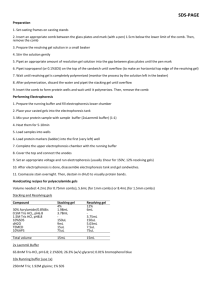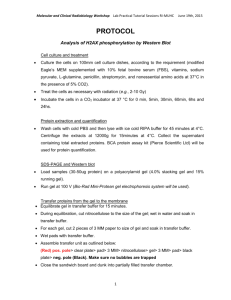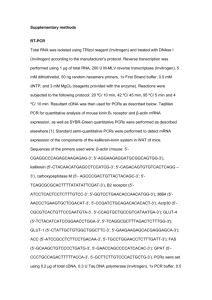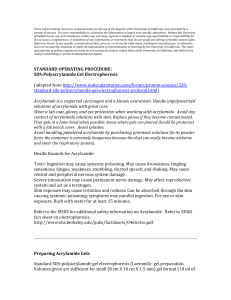SDS-PAGE - ProteinGuru
advertisement
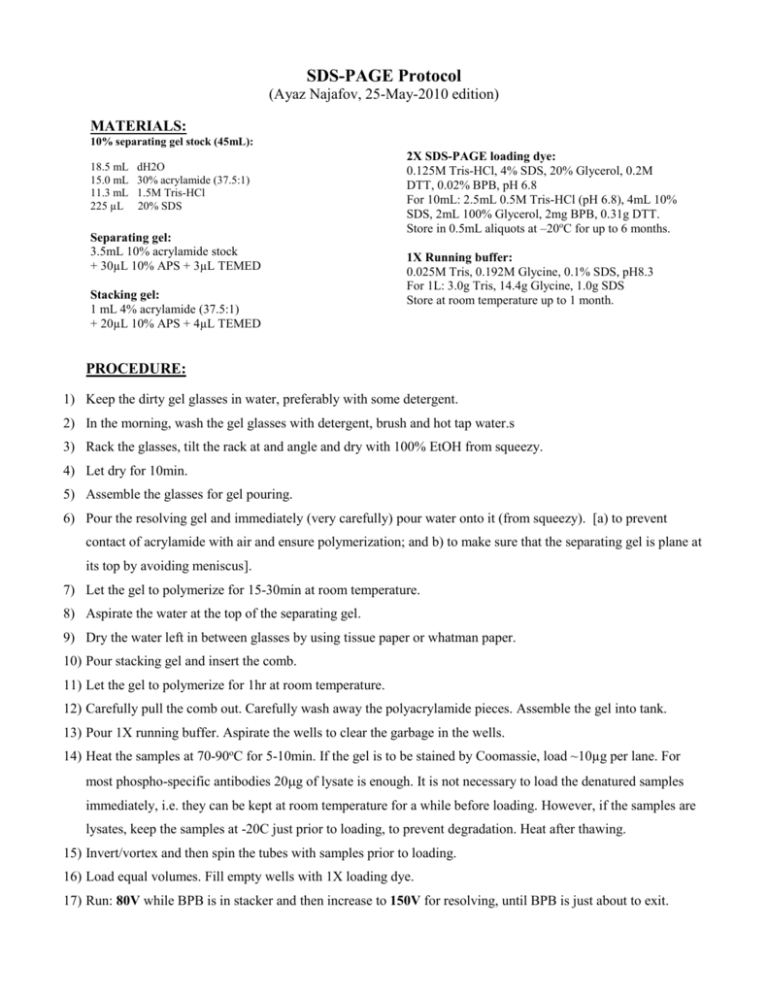
SDS-PAGE Protocol (Ayaz Najafov, 25-May-2010 edition) MATERIALS: 10% separating gel stock (45mL): 18.5 mL 15.0 mL 11.3 mL 225 µL dH2O 30% acrylamide (37.5:1) 1.5M Tris-HCl 20% SDS Separating gel: 3.5mL 10% acrylamide stock + 30µL 10% APS + 3µL TEMED Stacking gel: 1 mL 4% acrylamide (37.5:1) + 20µL 10% APS + 4µL TEMED 2X SDS-PAGE loading dye: 0.125M Tris-HCl, 4% SDS, 20% Glycerol, 0.2M DTT, 0.02% BPB, pH 6.8 For 10mL: 2.5mL 0.5M Tris-HCl (pH 6.8), 4mL 10% SDS, 2mL 100% Glycerol, 2mg BPB, 0.31g DTT. Store in 0.5mL aliquots at –20oC for up to 6 months. 1X Running buffer: 0.025M Tris, 0.192M Glycine, 0.1% SDS, pH8.3 For 1L: 3.0g Tris, 14.4g Glycine, 1.0g SDS Store at room temperature up to 1 month. PROCEDURE: 1) Keep the dirty gel glasses in water, preferably with some detergent. 2) In the morning, wash the gel glasses with detergent, brush and hot tap water.s 3) Rack the glasses, tilt the rack at and angle and dry with 100% EtOH from squeezy. 4) Let dry for 10min. 5) Assemble the glasses for gel pouring. 6) Pour the resolving gel and immediately (very carefully) pour water onto it (from squeezy). [a) to prevent contact of acrylamide with air and ensure polymerization; and b) to make sure that the separating gel is plane at its top by avoiding meniscus]. 7) Let the gel to polymerize for 15-30min at room temperature. 8) Aspirate the water at the top of the separating gel. 9) Dry the water left in between glasses by using tissue paper or whatman paper. 10) Pour stacking gel and insert the comb. 11) Let the gel to polymerize for 1hr at room temperature. 12) Carefully pull the comb out. Carefully wash away the polyacrylamide pieces. Assemble the gel into tank. 13) Pour 1X running buffer. Aspirate the wells to clear the garbage in the wells. 14) Heat the samples at 70-90oC for 5-10min. If the gel is to be stained by Coomassie, load ~10µg per lane. For most phospho-specific antibodies 20g of lysate is enough. It is not necessary to load the denatured samples immediately, i.e. they can be kept at room temperature for a while before loading. However, if the samples are lysates, keep the samples at -20C just prior to loading, to prevent degradation. Heat after thawing. 15) Invert/vortex and then spin the tubes with samples prior to loading. 16) Load equal volumes. Fill empty wells with 1X loading dye. 17) Run: 80V while BPB is in stacker and then increase to 150V for resolving, until BPB is just about to exit. For proteins >70kDa, run 8% gels. For proteins <70kDa, run 10% gels. Keep 8% and 10% pre-mixes (dH2O, Buf, SDS). Filter the pre-mixes. Prefer to use freshly thawed 10% APS. Keep thawed APS at 4oC for no more than 10 days. LDS sample buffer is better than SDS sample buffer. Acrylamide Solution (38:2) Acrylamide 190 g Bis 10 g H2O to 500 ml o Store in the dark at 4 C. Acrylamide is neurotoxic and should be handled with care. 1.5 M Tris-Cl (pH 8.8) Tris (MW 121.1) 36.3 g H2O to 200 ml Adjust pH to 8.8 with HCl. 0.5 M Tris-Cl (pH 6.8) Tris (MW 121.1) 6.06 g H2O to 100 ml Adjust pH to 6.8 with HCl. 10% SDS SDS H2O 10 g to 100 ml 10% Ammonium Persulphate Ammonium persulphate 1g H2O 10 ml Prepare fresh (can be stored at 4oC for a few days). 2X Sample Buffer (with beta-ME) 0.5 M Tris-Cl (pH 6.8) 2.5 ml 10% SDS 4 ml Glycerol 2 ml 2-Mercaptoethanol 1 ml Bromophenol Blue mg H2O to 10 ml Divide into 1 ml aliquots and freeze. 6X Sample Buffer (with DTT) 1 M Tris-Cl (pH 6.8) 2.4 ml SDS 0.96 g Glycerol 4.8 ml DTT 739 mg Bromophenol Blue 4.8 mg Do not adjust the volume. 5X Tank Buffer Tris (MW 121.1) 60 g Glycine 288 g SDS 10 g H2O to 2 l The pH of the solution does not need to be adjusted.

